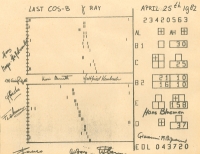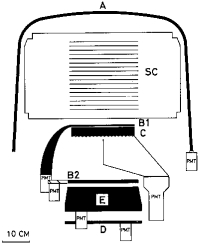Cos-B: 30 Years On
17 August 2005
On 9 August 1975 ESA's first scientific satellite, Cos-B, was launched. Cos-B was ESA's first foray into producing a spacecraft with a single payload: a high-energy gamma-ray telescope. The mission was a remarkable success and returned the first detailed observations of gamma-ray emission from within our galaxy.
 |
|
The Last Recorded Gamma-Ray |
The final detection was recorded for posterity and signed by all project members present in the control room at the time including: project scientist Kevin Bennett, who now works on ESA's Planck mission, and Giovanni Bignami, the current chair of the Space Science Advisory Committee.
Launch and Orbit
The spacecraft was launched on a Delta 2913 rocket from the Vandenburg Air Force Western Test Range in California. The orbit of Cos-B was roughly 100 000 km with a period of 37 hours. This eccentric orbit was chosen to ensure that for most of the time the satellite was outside the Earth's radiation belts. This led to an efficient viewing programme at the price of high cosmic-ray background.
The orbital plane was inclined at roughly 90 degrees to the Earth's equator and the argument of perigee was placed in the fourth quadrant to ensure that the satellite was in sight of one of the ESTRACK ground stations.
The Spacecraft
Cos-B was configured as a cylinder 1.40 m in diameter and 1.13 m long, with the main experiment package occupying the central region. The total height, including antennas and other structural supports, was 1.71 m. The total mass at launch was 278 kg, of which the experiment was 118 kg.
The satellite was spin-stabilised at about 10 rpm about its axis of symmetry, which coincided with the optical axis of the gamma-ray detector. Sun and Earth sensors were used for attitude measurements from which the pointing direction could be reconstituted with a precision of about 0.5 deg. The timing accuracy was 0.5 ms or better.
 |
|
Cos-B Spark Chamber |
Science Summary
The main achievement of Cos-B was the 2CG catalogue of point sources. This early catalogue was based on the selected data from only 30 observations made during the first three years of operation. It was searched for the presence of discrete, or localised, sources of gamma radiation under the assumption of a flat, or smoothly varying background. Thus 25 candidate sources were reported. In view of the availability of the total mission data as well as more realistic background models, the interpretation of these enhancements has evolved rapidly.
Most of the observations performed with Cos-B were devoted to the study of the galactic disc. A detailed and complete intensity map of the galaxy seen in the light of gamma radiation is shown below.
 |
|
Map of the Milky Way |
Light curves and spectra were derived for both the Crab and Vela pulsars. A major discovery resulted from comparing the light curves of the Vela and Crab pulsars for the different epochs. It is seen that while during several years the light curve of Vela remains unchanged the Crab's light curve varies.
Geminga, or 2CG195+4 is one of the brightest sources in the 2CG catalogue. First discovered by SAS2, the source stands out brightly in a low background region of the galactic disc. As a consequence of the favourable signal to noise, an accurate spectrum was determined.
The quasar 3C273 was subjected to repeated observations and the source appeared in three independent data sets. The combined data yielded an energy spectrum, which when combined with data from other wavelengths demonstrated for the first time that the luminosity of 3C273 peaks in the gamma-ray region.
Legacy
High-energy astrophysics has played a fundamental role in the activities of the Agency with EXOSAT, XMM-Newton and the INTEGRAL mission all building on the work of COS-B.


